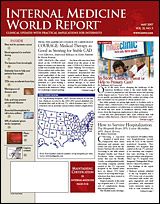Surgery Better than Endoscopy for Chronic Pancreatitis
Patients Perceive Endoscopic Treatment Safer, Allowing Faster Recovery
Surgical drainage is more effective than endoscopic treatment in patients with chronic pancreatitis and pancreatic duct obstruction, suggest the findings of a new study published in the New England Journal of Medicine (2007; 356:676-684).
The benefits of surgery in this patient population include more rapid and sustained pain relief when compared with endoscopic drainage, report lead investigator Djuna Cahen, MD, of the Academic Medical Center, Amsterdam, the Netherlands, and colleagues.
The optimal approach to ductal drainage is unknown in patients with painful chronic pancreatitis and pancreatic duct obstruction. Endoscopic therapy has emerged as an alternative to surgery for ductal decompression, but data from controlled, prospective studies of this approach are lacking.
In this study, 39 patients (aged 18-80 years) with symptomatic chronic pancreatitis and a distal obstruction of the pancreatic duct were randomized to undergo surgical pancreaticojejunostomy or endoscopic transampullary drainage. The primary outcome measure was the mean Izbicki pain score during 24 months of follow-up. Secondary outcome measures included physical and mental health, mortality, and length of hospital stay.
The patients randomized to endoscopic treatment had a median of 5 endoscopic procedures (range, 1-11); the overall technical success rate was 53%.
Of the 20 patients randomized to surgical treatment, 7 (35%) had complications, but none died. The technical success rate, defined as maintenance of anastomosis patency during follow-up, was 100%.
The mean Izbicki pain score during follow-up was significantly lower in the surgery group than in the endoscopy group (25 vs 51; P <.001). Pain relief was immediate and consistent during follow-up in the surgery group. At the end of the 24 months of follow-up, pain was relieved completely (pain score ≤10) or partially (pain score >10 after a decrease of 50%) in 75% of the surgery group and in 32% of the endoscopy group (P = .007).
The physical component of the quality-of-life score was significantly lower in the endoscopy group than in the surgery group (P = .003). Both groups had similar mental health scores and lengths of hospitalization.
Despite the advantages of surgery, many patients with chronic pancreatitis perceive endoscopic treatment to be safer and simpler, and to offer a faster return to normal activities, writes Grace Elta, MD, of the University of Michigan, in an accompanying editorial (pages 727-729). “Patients should be forewarned, however, that endoscopic therapy requires several endoscopic sessions and has a lower long-term success rate than surgery,” she adds.
Definitive criteria for the identification of patients with chronic pancreatitis who are better suited for surgical or endoscopic treatment remain elusive. “This is really a matter of patient choice, although in general I would favor surgery in young, otherwise-healthy patients,” Dr Elta told IMWR. “Many patients of all ages are anxious to avoid surgery, which remains an option should endoscopic treatment fail.”
